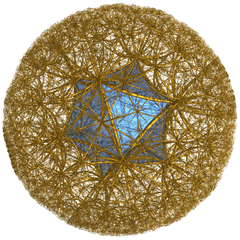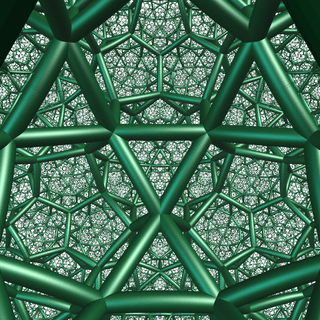Icosahedral honeycomb
| Icosahedral honeycomb | |
|---|---|
 Poincaré disk model | |
| Type | regular hyperbolic honeycomb |
| Schläfli symbol | {3,5,3} |
| Coxeter-Dynkin diagram | |
| Cells | icosahedron {3,5} |
| Faces | triangle {3} |
| Edge figure | triangle {3} |
| Vertex figure |  dodecahedron |
| Dual | Self-dual |
| Coxeter group | J3, [3,5,3] |
| Properties | Regular |
The icosahedral honeycomb is one of four compact regular space-filling tessellations (or honeycombs) in hyperbolic 3-space. With Schläfli symbol {3,5,3}, there are three icosahedra surround each edge, and 12 icosahedra surround each vertex, in a regular dodecahedral vertex figure.
The dihedral angle of a Euclidean icosahedron is 138.2°, so it is impossible to fit three icosahedra around an edge in Euclidean 3-space. However in hyperbolic space, properly scaled icosahedra can have dihedral angles exactly 120 degrees, so three of these fit around an edge.
Images

Related honeycombs
There are nine uniform honeycombs in the [3,5,3] Coxeter group family, including this regular form as well as the bitruncated form, t1,2{3,5,3}, ![]()
![]()
![]()
![]()
![]()
![]()
![]() , also called truncated dodecahedral honeycomb, each of whose cells is a truncated dodecahedron.
, also called truncated dodecahedral honeycomb, each of whose cells is a truncated dodecahedron.
The rectified icosahedral honeycomb, ![]()
![]()
![]()
![]()
![]()
![]()
![]() , has alternating dodecahedron and icosidodecahedron cells, with a triangular prism vertex figure:
, has alternating dodecahedron and icosidodecahedron cells, with a triangular prism vertex figure:
-

Perspective projection from center of Poincaré disk model
See also
- Seifert–Weber space
- List of regular polytopes
- Convex uniform honeycombs in hyperbolic space
- 11-cell - An abstract regular polychoron which shares the {3,5,3} Schläfli symbol.
References
- Coxeter, Regular Polytopes, 3rd. ed., Dover Publications, 1973. ISBN 0-486-61480-8. (Tables I and II: Regular polytopes and honeycombs, pp. 294-296)
- Coxeter, The Beauty of Geometry: Twelve Essays, Dover Publications, 1999 ISBN 0-486-40919-8 (Chapter 10: Regular honeycombs in hyperbolic space, Summary tables II,III,IV,V, p212-213)